Have you ever sent out a feedback survey to a customer or anyone else involved with your organization, one that looks something like this:
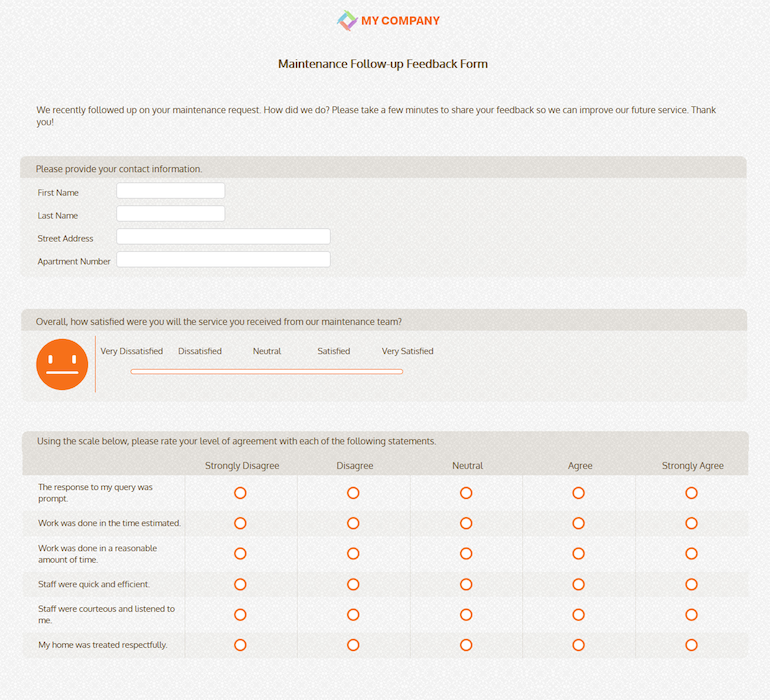

Source: SoGoSurvey
If you have, you’ve conducted quantitative market research.
But quantitative research is not limited to feedback surveys. Regardless of the industry, you can get so much more out of it. It can give you an idea of:
- Industry trends and patterns.
- Your strengths and weaknesses.
- Change in your target audience’s opinions or behavior.
Collectively, these insights help you make informed decisions about your organization’s objectives, operations, marketing, etc.
So how exactly do you go about conducting quantitative market research? This post shows you. First, we start by understanding a little more about what this type of market research is.
What is meant by quantitative market research?
Quantitative research entails collecting answers and opinions from a target audience on different subjects. This data is usually quantifiable or numerical.
Typically, the questionnaire is designed with close-ended questions and multiple options to choose from.
This data is collated and analyzed using computational, mathematical, or statistical techniques, and the results are presented as numerical data. These results are then used to:
- Understand market trends, opinions, and predictions to ensure your relevance.
- Validate assumptions of your strengths, weaknesses, opportunities, and challenges.
- Inform operational, product, or positioning decisions.
- Test your relationship with your audience.
Let’s walk through an example to understand this better.
A market research company, Tallwave, worked with a leading food distribution company to help them during the pandemic.
The objective was to identify the changes in the needs and values of their restaurant clients and look for opportunities to help them become more valuable partners.
Tallwave created a survey and emailed it to the clients. The survey consisted of questions like:
- The percentage of their weekly spend with the food distribution company.
- Percentage change in the amount of food they were ordering now.
- A satisfaction rating of the food distribution company.
The results showed how the pandemic changed:
- Their weekly orders and demand.
- Customer count.
- Operations and purchase behavior.
These findings helped the food distributor align with customer needs and changes while regulating their procurements based on demands.
Advantages and disadvantages of quantitative market research
Having quantifiable insights has a few distinct advantages but a few drawbacks too. These are as follows.
| Advantages | Disadvantages |
| Larger sample sizes: Since quantitative research surveys are smaller and easier to fill, you can distribute them to a larger audience in a given time. | Lack of specific data: Since the focus is on numbers, you could end up with inconclusive results. For example, the number of unsatisfied customers but no clue why. |
| Easy analysis: Since the data is numerical, it’s easy and efficient to analyze using available tools. | Difficulty in following up: It’s hard to follow up with respondents and ask them more questions based on their responses. |
| Faster insights: Given that analysis is more straightforward; you get these insights immediately. | No control over the environment: You don’t know when and how respondents fill out the survey. You also can’t judge their emotions, so you could get skewed data. |
| Generalized findings: Since the research typically finds trends, the results can be safely generalized beyond the participants. |
You May Also Like: Why Is Market Research Important For Your Organization? All Essential Reasons
Next, let’s look at some of the most common quantitative market research methods.
Quantitative market research methods
Some of the most popular ways to distribute surveys for quantitative market research are:
- Face to face
- Postal surveys
- Online surveys
- Text surveys
- Telephone surveys
Let’s take a closer look at what the process for each entails.
Face to face surveys
Face to face or in-person surveys are generally conducted either by:
- Going door-to-door or
- Approaching gatherings like an event or assembly.
The process for both is pretty straightforward. The steps include the following:
- Surveyors prepare their questionnaires. Some print them out, while some may use tablets and surveying tools like QuickTapSurveys.
- They approach the target audience, collect their details, and note the responses.
- Once they’re back to their organization, they enter the responses and details in a shared sheet or tool for analysis. This step, however, only applies to people using printed sheets to collect data.
While in-person surveys give you some control over the environment (typically a disadvantage with these surveys), it involves a lot of grunt work and can be expensive and inefficient.
Postal surveys
Postal surveys are letters sent out to either:
- Existing lists of respondents.
- Lists procured from list selling organizations.
They were created as an alternative for in-person surveys to avoid the hassle of going door-to-door.
The process for these surveys is as follows:
- Prepare the questionnaire with the necessary fields to collect responses. For example, options to tick for MCQ questions, text boxes for subjective answers.
- Print out the letter body and addresses for mailing. A direct mailing tool like Sendoso might be handy here.
- Add a response device to all letters. This return letter includes all the relevant details (like the return address, stamps). So survey respondents only have to fill out the survey, put it back in the envelope, and drop it in a postbox.
- Collect the responses, enter them into your sheet or tool for analysis.
Postal surveys do take away some effort in going around collecting responses. But the difficulty in tracking responses and manual data entry can still be quite challenging.
Online surveys
The internet age provided surveyors with another survey distribution channel for quantitative market research. Organizations could leverage the following to put their questionnaires out:
- Social media (via ads and organically)
- Search engine ads
- Emails
- Their website
- Third-party survey websites
The process is also straightforward:
- Prepare a questionnaire using a hosted tool like Google Forms or a self-hosted one like LimeSurvey. Get a shareable link to the survey.
- Promote the link via ads, publish it organically, or leverage other marketing efforts to get it in front of the right people.
- Collect responses, and since everything happens online, all data is automatically transferred to your CRM for analysis.
However, deliverability is a challenge with online surveys. It is often hard to get the right people to see the questionnaire, and there is also no way to validate who’s taking the survey.
Plus, pushing out the survey too can be challenging. It always has to be accompanied by alternative efforts like ads and SEO to get it to rank higher in search engines, social media marketing, etc.
You May Also Like: What is the Right Way to Conduct Online Market Research? All the Techniques Explained
Text surveys
With over 97% of the population owning a cell phone and an open rate of 98%, text surveys overcome the challenge of deliverability.
There are two ways you can leverage text surveys for quantitative market research:
- SMS Opt-in for inbound surveys.
- Peer-to-peer texts and text blasts for outbound surveys.
Here’s how they work.
SMS Opt-in (inbound text survey)
SMS opt-in surveys are used when you don’t have a contact list of your own. So instead of promoting the survey, you advertise a keyword and number and get people to opt-in to your list and take the survey. Generally, there’s an incentive involved to compel people to opt-in.
- Select a number to receive incoming messages. It could be a shortcode or a 10 digit long code (or 10DLC). Recent regulatory changes have made 10DLC numbers more favorable and efficient. Learn more about the challenges 10DLC solves.
- Assign a keyword that interested respondents text you. Make sure it’s related to the campaign and easy to remember—for example, FEEDBACK for a feedback survey.
- Create an auto-response flow. You can either send the survey questions on the same text chain or share a link to the survey form (as shown). The former is suitable for quick surveys with two to three questions, whereas the latter is better for longer ones.
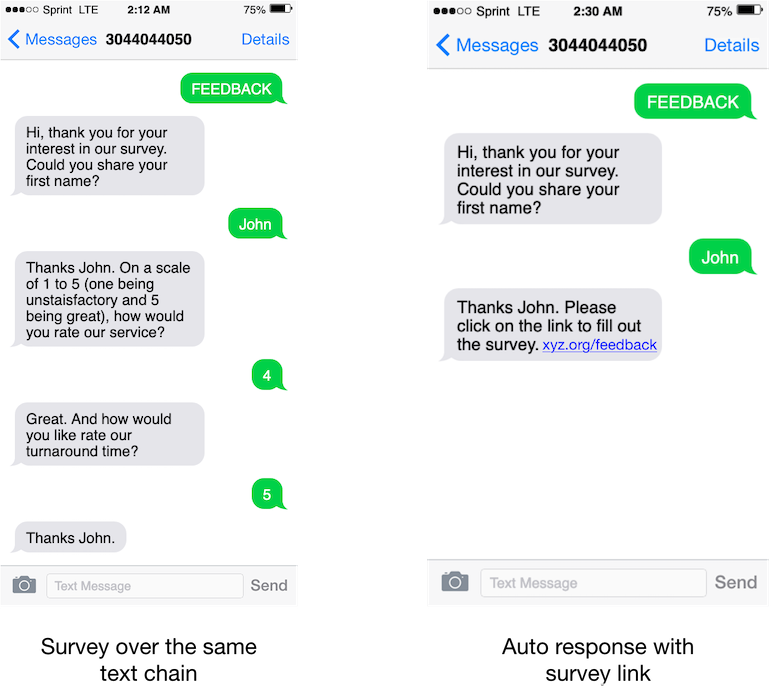

Peer-to-peer text (outbound survey)
Peer-to-peer texts allow you to have full conversations over text at scale, making them perfect for long and dynamic surveys for quantitative market research.
- Select a number to send messages from and upload the target contact list in your SMS tool.
- Draft your initial message that asks your contacts to participate in the survey. You can’t just start asking questions. People may not respond to it without some encouragement. It may also annoy them since you’re asking them for something without asking for their permission or giving them a reason.
- Draft follow-up templates that consist of the questions you wish to ask them. You can also craft a few saved replies to common questions contacts may have.
- Send out the initial message and the follow-up questions based on the responses.
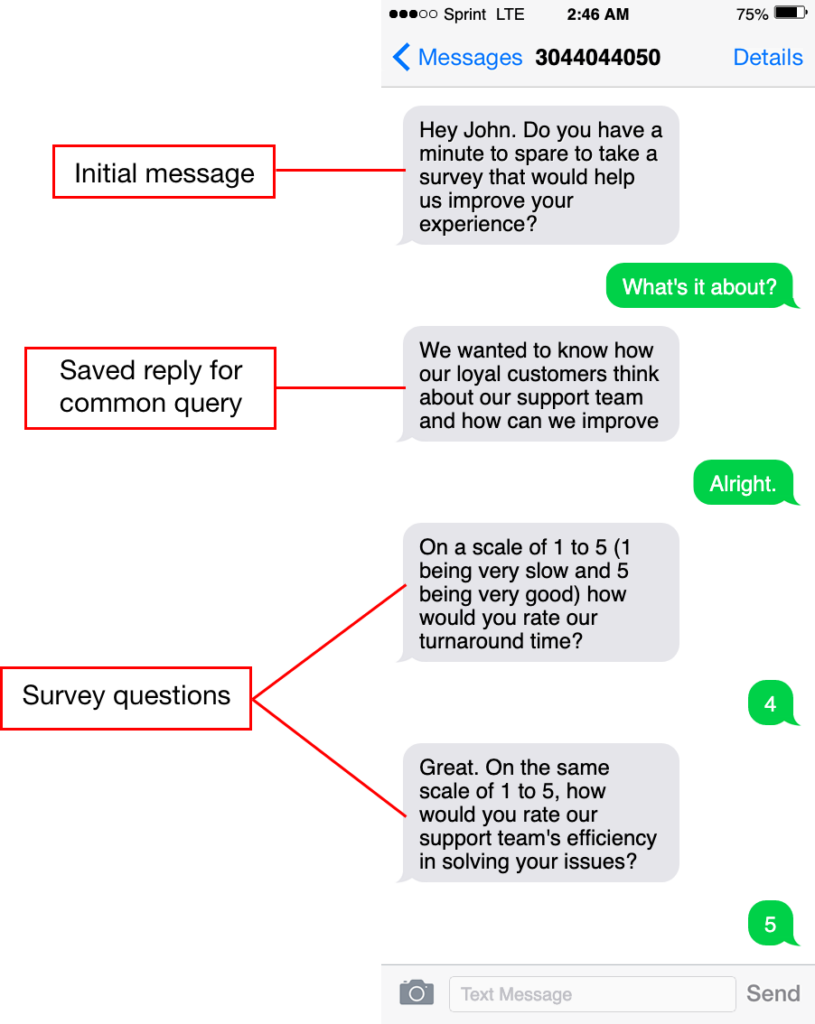

The integration of your SMS tool and your CRM ensures that the data is automatically exported to your CRM and ready for analysis. It eliminates the manual effort of entering data.
Text broadcasts (outbound survey)
Text broadcasts (or blasts) are an alternative outbound survey methodology that lets you send out the survey link to a large audience in one go. Here’s what the process entails:
- Select a number to send messages from and upload the target contact list.
- Draft your message. This message consists of the survey link and a compelling copy asking recipients to fill it out.
- Schedule the message and send it out to your contact list.
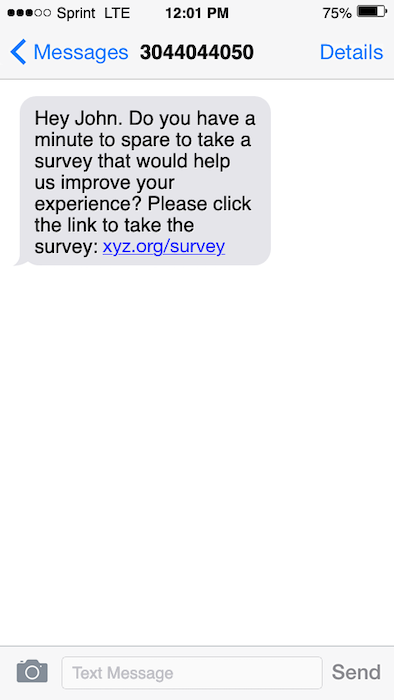

All responses are available in the survey form tool (in a hosted solution) or your CRM (in a self-hosted solution).
To learn more about setting up a text survey campaign and its benefits, check out our guide on Text surveys.
Telephone surveys
Telephone surveys bring the personal nature of face-to-face surveys and the reach of online surveys together while eliminating the need for manual data entry.
The dynamic conversations that phone calls let you have make them perfect for qualitative research. But they also work really well for quantitative market research.
The process is pretty simple:
- Set up a calling campaign in your call center software and upload your contact list. You can either import this list from your CRM or upload a CSV file.
- Select a number/s to make calls from. Having a dynamic caller ID feature comes in handy here. If you’re making calls across regions, the feature automatically rents out local numbers to make calls from. This helps improve pick-up rates as studies have shown that people are 4X more likely to pick up calls from local numbers.
- Draft your survey script. For quantitative market research, a calling tool that lets you craft a script with selectable options would be perfect. Here’s an example of this from CallHub’s dashboard:
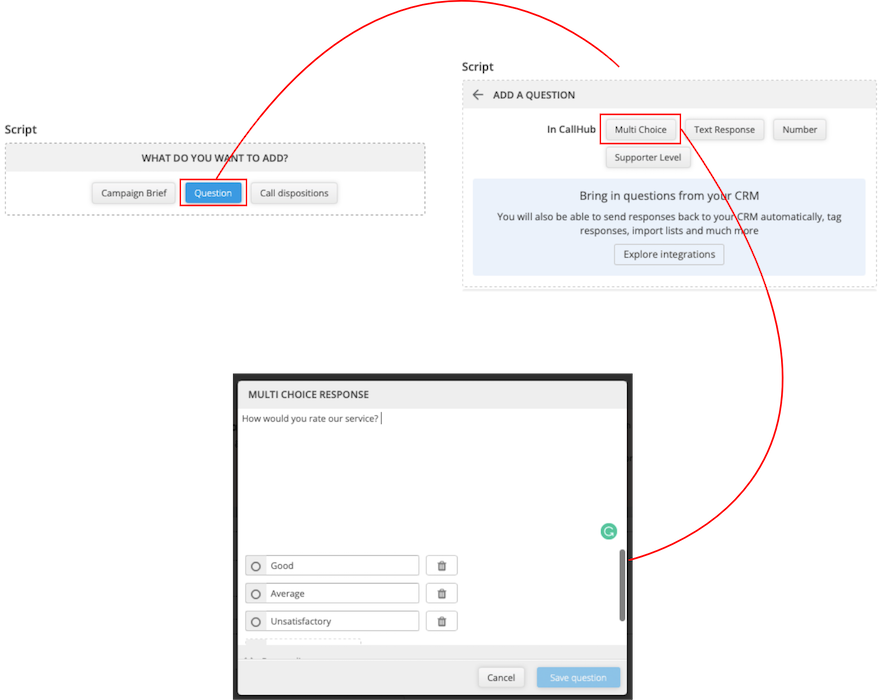

- Schedule your campaign and start making calls. As your surveyors collect responses, they are automatically exported to your CRM.
Learn more about setting up a telephone survey campaign in our guide on Phone Survey Software.
To summarize
Quantitative market research helps you collect quantifiable data to inform business decisions from your audience.
While the results can sometimes be a little inconclusive, it does provide you with a plethora of quick insights and trends that tell you where an organization stands and how it should move forward.
In-person, direct mail and online are a few ways to conduct surveys for quantitative market research. But in recent times, text and telephone surveys are taking over, given how they overcome some complex challenges associated with former methods.
That means if you’re not conducting surveys over text or calls, you should start immediately. And the journey for that starts from finding the right communication software to help you.
CallHub is a communication platform that offers calling and texting solutions with the perfect set of features that make quantitative market research a breeze. Sign up and try it out for free.
But, if you have already been conducting text and telephone surveys, maybe you could make a quick comparison of CallHub’s features against your existing tool—just to ensure that you have all the right features that are helping you operate with maximum efficiency. 😉
Featured image source: Photo by Tara Winstead from Pexels

